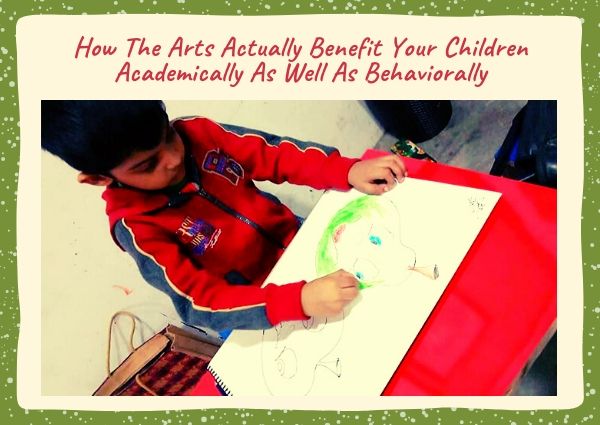How The Arts Actually Benefit Your Children Academically As Well As Behaviorally
In the following, we’ll be discussing a vital topic that’s “How the arts benefit Your Children academically and behaviorally” and will discuss it thoroughly within the article. The arts are gaining a resurgence in support as research shows benefits for kids academically, as well as improvements in behavior and attendance as compared to the past, where they were underfunded. Nowadays in our country, music, dance, theater, and also visual arts are still an integral component of education similarly as they were an integral part of Greek society.
The trend towards expanding arts education is a positive one for sure because the advantages that students reap from participation within the arts are quite a lot. In fact, research shows that the arts promote positive development within the academic, social, and emotional realms. So arts are so important to a comprehensive educational program, that some even proclaims that, “The arts are what make us most human, most complete as people.”
Signs Of Support
The arts are gaining more and more recognition as a central component of the general public school curriculum rather than as an add-on that students elect to take in high-school or participate in only once or twice per week as an elementary school student. The arts are treated as a core academic subject because of the No Child Left behind Act, along with science, social studies, language arts, math as well as other disciplines. Furthermore, all 50 states have academic content standards for a minimum of one discipline within the arts.
Additionally, even public opinion is in strong favor of the arts. Ninety-three percent of American citizens believe that the arts are critical for a well-rounded education. In fact, more than 1/2 of Americans rate the importance of the arts as a ten on a scale from one to 10. Furthermore, the public also overwhelmingly sees the connection between participation in the arts as well as improved academic achievement, as the positive correlation between actually studying the arts and improved social as well as emotional skills.
Academic Benefits
Multiple research studies support the notion that students who engage in the study of the arts perform better in math, reading, and writing. The Arts Education Partnership actually performed a meta-analysis of 62 studies that revealed that students who study music have increased or far greater achievement as well as proficiency in math. Reading and cognitive development were found to extend, as were verbal SAT scores.
The same study shows that the visual arts have a positive impact on students’ ability to arrange their writing. Sophisticated reading skills are promoted as well, including the power or ability to interpret complex texts, like those found in science courses. Students that take a mixture of arts programs demonstrate improved verbal, reading, and math skills, and also show a greater capacity for higher-ordered thinking skills like analyzing and problem-solving.
Research conducted in public schools in 2011 further shows the link between the arts and improved academic achievement. In courses within which the arts are integrated with math, science, social studies, and other subjects, students demonstrated marked improvements in reading and math. Moreover, district-level successes have also been reported for students that are actually involved in the fine arts.
Behavioral Benefits
The benefits of art courses extend beyond the educational realm. A number of studies have shown that the arts have a positive influence on student behavior and school climate also. Moreover, the Arts Education Partnership analysis actually revealed that particularly drama courses helped students actually develop an improved understanding of social relationships as well as complicated or complex emotional problems or issues. Furthermore, students in dance courses were found to demonstrate a greater and high capacity for social tolerance, positive self-expression as well as self-confidence.
A 2010 study found an inverse relationship between studying the arts and disciplinary infractions. In school districts in which there was a higher percentage of students enrolled in art classes, there were fewer reported behavioral incidents. This actually includes violent outbursts as well as other behaviors that resulted in actual out of school suspensions. Moreover, suspensions as a whole, especially those of 10 days or more, were actually markedly lower in schools that had robust arts programs. In fact, schools with low student enrollment within the arts reported nearly twice as many disciplinary incidents as schools with high student enrollment within the arts.
Benefits for Low SES Students
Perhaps the best advantage of the arts is seen amongst student populations that come from economically disadvantaged homes. A report by the National Endowment for the arts actually reveals that students with a low SES (i.e. socioeconomic status) that have a history of involvement within the arts have better long-term academic, occupational as well as social outcomes than their peers. Specifically, high arts involvement led to more students aiming to attend college and increased the likelihood that students would apply to a moderately or highly selective college. Moreover, low SES (i.e. socioeconomic status) students who had actually experienced in the arts were found to be 3 times as likely to earn a bachelor’s degree as their peers.
These students also demonstrated higher overall career goals. Participation within the arts was actually correlated with higher occupational aspirations, which include choosing a major that’s actually aligned with a professional and knowledgeable career, like accounting, nursing, or even education. Additionally, 1/2 of low SES students with arts-rich K-12 experiences expect to work during a professional career like law or medicine, compared to merely 21 percent of low SES students who haven’t had the advantage of access to the arts.
Furthermore, the arts even provide social benefits for at-risk students. The study by the National Endowment for the arts shows that students with arts-rich high-school experiences demonstrate more civic engagement and civic-minded behavior than students who attended schools without such robust arts programming. Arts students reported higher participation in volunteer activities, additionally as greater engagement in national elections than their peers.
Conclusion
It’s clear from the research that arts programming for K-12 students are of the utmost importance, not just for their short-term success, but for their long-term success as well. In the short-term, students demonstrate positive growth within the realms of actual academic achievement and behavior. Additionally, in the long-term, children develop quite critical skills that improve their lifelong ability to read, write as well as communicate effectively. Participation within the arts as a youngster even improves the likelihood that that child will go to college and obtain a decent job.
The arts don’t discriminate based on age, race, gender, or any other sort of measure. Their study provides benefits for students of all types, shapes, and sizes. When there are numerous obstacles that children must overcome, particularly minority students and poor students, the arts can quite literally be the lifeline they need to form long-lasting improvements to their life.


